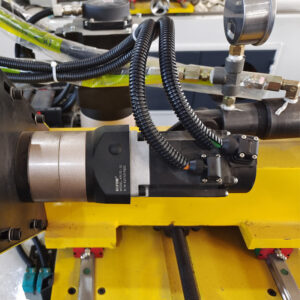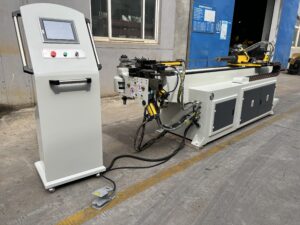Which Tube Benders Is Perfect for You?
When it comes to choosing the right tube benders, the decision can feel overwhelming. With countless models, features, and manufacturers available, it’s essential to select a machine that aligns with your specific needs and applications. Whether you’re in aerospace, automotive, construction, or manufacturing, the right tube bender can significantly impact your productivity, precision, and profitability.

What Are Tube Benders and Why Are They Important?
Tube benders are machines designed to bend metal tubing and piping into specific angles and shapes without compromising the material’s integrity. Whether you need simple 90-degree bends or complex, multi-radius designs, the right tube bender ensures consistency, reduces material waste, and improves efficiency.
Types of Tube Benders
To understand which tube bender is perfect for you, it’s crucial to first explore the different types of tube benders available on the market. Each type is suited for specific applications, materials, and levels of precision.
1. Manual Tube Benders
Manual tube benders are simple, cost-effective tools operated by hand. They are ideal for small-scale projects and applications that don’t require high precision or complex bends. Commonly used in maintenance, DIY projects, and light fabrication, manual benders are a great choice for hobbyists or those working with softer materials like aluminum.
Advantages:
- Affordable and easy to use
- Suitable for low-volume tasks
- Portable and lightweight
Limitations:
- Limited precision and repeatability
- Not suitable for high-strength materials or complex bends
2. Hydraulic Tube Benders
Hydraulic tube benders use hydraulic pressure to create bends, offering more power and precision than manual benders. These machines are commonly used in industries like automotive and construction, where thicker and stronger materials need to be bent.
Advantages:
- Capable of bending thicker tubes
- Higher accuracy than manual benders
- Suitable for mid-volume production
Limitations:
- Slower than CNC or electric benders
- Requires more maintenance
3. CNC Tube Benders
Computer Numerical Control (CNC) tube benders are the most advanced and precise machines available. They are fully automated and controlled by computer programming, making them ideal for industries that demand high precision, such as aerospace and automotive manufacturing.
Advantages:
- Unmatched precision and repeatability
- Capable of producing complex bends and geometries
- Efficient for high-volume production
Limitations:
- Expensive initial investment
- Requires skilled operators and programming knowledge
4. All-Electric Tube Benders
All-electric tube benders combine precision, efficiency, and eco-friendliness. These machines use electric motors instead of hydraulics, making them cleaner and more energy-efficient. They are ideal for industries that prioritize sustainability and precision, such as medical device manufacturing and aerospace.
Advantages:
- High energy efficiency
- Exceptional accuracy and control
- Low maintenance
Limitations:
- Higher upfront cost
- Limited to specific applications
5. Rotary Draw Benders
Rotary draw benders are commonly used for applications requiring tight radii and consistent bends, such as in the production of roll cages, exhaust systems, and structural frameworks.
Advantages:
- Excellent for tight-radius bends
- High repeatability
- Suitable for complex geometries
Limitations:
- Not ideal for large-diameter pipes
- Requires skilled operation
Factors to Consider When Choosing a Tube Bender
Now that you’re familiar with the different types of tube benders, it’s time to evaluate which one suits your needs. Here are some key factors to consider:
1. Material Type
Different materials have varying levels of malleability and strength. For instance, softer metals like aluminum can be bent with manual or hydraulic benders, while harder materials like stainless steel or titanium may require CNC or all-electric benders.
2. Tube Diameter and Wall Thickness
The size of the tubing you need to bend will influence your choice. Larger diameters and thicker walls require more powerful machines, such as hydraulic or CNC benders.
3. Complexity of Bends
If your project involves intricate designs or multiple bends, a CNC or rotary draw bender is essential for achieving the required precision and consistency.
4. Production Volume
For low-volume or one-off projects, manual or hydraulic benders are cost-effective options. However, for high-volume production, CNC or all-electric benders provide the speed and efficiency needed to meet demand.
5. Budget
Your budget will play a significant role in determining which tube bender you can afford. While CNC and all-electric benders have a higher upfront cost, they often provide long-term savings through efficiency and reduced material waste.
Real-World Case Study: Choosing the Right Tube Bender for an Aerospace Project
Scenario: An aerospace company needed to produce hydraulic tubing for a new aircraft model. The tubing required tight-radius bends with tolerances of less than 0.01 inches.
Challenge: The company initially used a hydraulic bender, but the results were inconsistent, leading to frequent rework and material waste. They needed a solution that could achieve precise, repeatable bends while minimizing waste.
Solution: After evaluating their requirements, the company invested in an all-electric CNC tube bender. This machine provided the precision needed to meet aerospace tolerances and the efficiency to handle their production volume. Additionally, the CNC programming allowed for easy adjustments and repeatability, reducing setup times and errors.
Outcome: By switching to an all-electric CNC bender, the company reduced material waste by 25%, improved production efficiency by 40%, and met the rigorous standards of the aerospace industry.
Tips for Maximizing the Performance of Your Tube Bender
- Regular Maintenance: Keep your machine in top condition to ensure consistent performance.
- Operator Training: Invest in training for your operators to maximize the capabilities of your tube bender.
- Use Quality Tooling: High-quality dies and mandrels reduce defects and improve the lifespan of your machine.
- Leverage Automation: For CNC and all-electric benders, use automation to streamline production and reduce human error.



